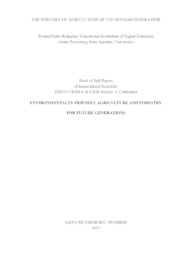Tillage systems with controlled traffic and limits to maize production.
Tillage systems with controlled traffic and limits to maize production.
Author(s): TREIN, C. R.; MORAES, M. T. de; LEVIEN, R.; MAZURANA, M.; ANGHIGNONI, I.; DEBIASI, H.; BONETTI, J. A.
Summary: Soil compaction can reduce the growth of crops, causing production losses even in soil conservation systems. In areas where controlled traffic is used, the wheeled rows are prone to show limiting conditions for corn growth and production. Determination of soil critical values limiting plant growth and corn grain productivity in areas with controlled traffic would be a valuable tool to adopt controlled traffic. Aiming the assessing of critical values to soil compaction an experiment was designed on a Rhodic Paleudult as random blocks in factorial scheme 2x4x5 (tillage x wheeling x soil layers), with three replications. Maize was sown with direct drilling (zero tillage) and reduced tillage (chiseling) system. A tractor with 3.8 Mg was used to compact soil in both systems (0, 1, 3 and 6 wheeling) prior to sowing. The soil density, macro porosity and field capacity were determined in undisturbed soil samples taken at 0-5; 5-10; 10-15; 15-20 and 20-25 cm dept layers. Soil penetration resistance (PR) was evaluated in the field as well. Regardless of tillage system, traffic increased agricultural soil density values even to the depth of 20 cm. The highest value of PR (1600 kPa) and soil density (1.67 Mg m-3) were not limiting to maize growth and the productivity of corn grains increased on wheeled soil. Water content of the soil after wheeling, at field capacity, was increased by up to 0.1 m3 m-3 and the macro porosity was reduced in 10%. The grain production of corn was higher in wheeled soil. The values of soil density and PR were not limiting to root growth. Wheeling the soil even up to six times with tractor, did not limit maize growth, and showed increases in grain productivity.
Publication year: 2015
Types of publication: Paper in annals and proceedings
Unit: Embrapa Soybean
Observation
Some of Embrapa's publications are published as ePub files. To read them, use or download one of the following free software options to your computer or mobile device. Android: Google Play Books; IOS: iBooks; Windows and Linux: Calibre.
Access other publications
Access the Agricultural Research Database (BDPA) to consult Embrapa's full library collection and records.
Visit Embrapa Bookstore to purchase books and other publications sold by Embrapa.

